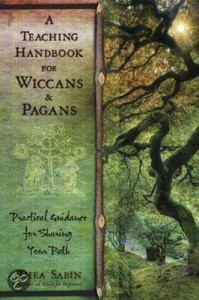A Teaching Handbook for Wiccans & Pagans. Practical guidance for sharing your path
Thea Sabin
Llewellyn, 2012, 299 p. ISBN 978-0-7387-2710-3. € 17,95.
Thea Sabin wrote Wicca for Beginners that was reviewed positively. And rightly so, because Sabin succeeded in describing the philosophy and the practice of (traditional, initiatory) Wicca for beginners. Now she presents a guide for all teachers of Wicca and the broader field of Paganism. Because: “As the Pagan and Wiccan communities grow, so does the need for teachers, mentors, and role models. For those who want to share their knowledge, teaching can be a very empowering and spiritual experience. But practicing the Craft and teaching it are two different things.”
One does need a basic knowledge of the subject before being able to teach it. But just having a certain knowledge does not make one a teacher, though some people seem to be born teachers. It helps to learn a little about teaching before you actually take on students. Sabin wrote the Pagan teacher training manual she’d wished she had when she began teaching. She describes techniques and best practices and thus gives tools to the people who contribute to their community as teachers. Sabin does not only share her own experiences, but interviewed other teachers in Wicca and Paganism who share their knowledge. Among those T. Thorn Coyle, Pete ‘Pathfinder’ Davis, Ellen Evert Hopman, Patrick McCollum and Oberon Zell-Ravenheart and the director of Cherry Hill Seminary: Holli Emore.
In my opinion the book is valuable for lots of teachers outside of Paganism too. Maybe even more to a more general group of teachers than to a core of Wiccans (or to Wiccans teaching other subjects than Wicca). The idea of whole classes studying Wicca is new to me. We (Gardnerians in the Netherlands, in the Silver Circle tradition) are used to one-on-one training, either in a correspondence course or student and teacher meeting in person. Having more than one or two students at the same time, in the same phase of learning, does not occur often, in my experience. And – depending on tradition – only some training is done before initiation, and the rest afterwards. I asked around, and advertising courses in Wicca is not very common either. Wiccan teachers can be found, but you have to search. There’s a list of contacts in the Arachnes’ Web pages in this online magazine (our equivalent of Witchvox listings of local Pagans). You can come into contact with teachers in pubmoots (‘Witches’ cafés’), through Wiccan and Pagan forums on the internet or by asking around. But advertising courses in real adds in magazines does not happen.
So not everything in this book applies to every possible Wiccan or Pagan teacher. Having said that: the guide is very complete and informs potential teachers of everything they could encounter. Where do you find students (or how do they find you)? How do you screen them? What are adult teaching styles – adults ask for other methods of teaching than children or teenagers! Where are you going to teach (at home, in the local library or Pagan bookshop, in a community center?) How do you prepare your lessons? How can you teach online, what facilities are there to aid you and your students? Some problems are more urgent to Wiccans and Pagans than to other teachers. Since there still are many misapprehensions and prejudices about Paganism, let alone Wicca, not everyone will be able or willing to invite interested people at home. And there’s the issue of money: most Wiccans do not charge for passing on the tradition, other than expenses. How much money will it cost you to teach? And how much in terms of space, time, energy? When you do make a business out of your teaching, there are legalities to consider: insurances, taxes, licenses. And waivers of liability, or waivers of permission signed by the parents when you teach minors.
What I particularly like about this teaching handbook, are the chapters on ‘A few possible pitfalls’ and ‘Care and feeding of the teacher’. One of the advices to avoid or address pitfalls is ‘not avoiding conflict’. Communicate clearly with the students. And in an early stage of conflict, or better even: before a situation turns into a conflict. Some teacher-specific challenges are ‘hubris and believing your own hype’ and ’the guru syndrome’. But also ‘exhaustion and burnout’ and ‘facing your own demons’ are dealt with. A final chapter is about Pagan clergy. Once you’re established as a teacher, you may be asked to perform marriages and burials too, or to do interfaith work or (prison) ministry. Appendixes give ‘screening questions’ and ‘sample syllabuses’, a list of resources and an index.
Highly recommended for teachers in the Pagan communities and outside of these!

